Javed Bari, Morshedul Haque Sunny, Sattyjit Kumar Nag, Shakhawat Hossain Tushar, Md. Touhidul Haque
Department of Civil and Environmental Engineering (DCEE), North South University, Bangladesh
Correspondence to: Javed Bari, Department of Civil and Environmental Engineering (DCEE), North South University, Bangladesh.
| Email: |  |
Copyright © 2018 The Author(s). Published by Scientific & Academic Publishing.
This work is licensed under the Creative Commons Attribution International License (CC BY).
http://creativecommons.org/licenses/by/4.0/

Abstract
This paper summarizes development, calibration and validation of Sidewalk Condition Index (SCI) for Dhanmondi residential are (R/A), Gulshan and Bashundhara R/A of Dhaka, the capital city of Bangladesh and one of the most densely populated cities of the world, having almost 20 million people. The main objective of this study was to develop a sustainable methodology to assess the condition of sidewalks using SCI that would mandate pedestrian safety. The study included literature review, detail condition survey of sidewalks in the Dhanmondi, Gulshan and Bashundhara areas of Dhaka City, assessment of the distress type, severity and frequency, analysis of the assessment, development of a methodology for determining SCI for the study area, calibrating the proposed methodology and finally, validating it. The methodology developed in this study may be used as an effective sidewalks management protocol by the local government authorities (such as city corporations). The study also included a survey among the pedestrians and recorded their experiences and expectations about the use of sidewalks and thoughts about their improvements. The study developed a Sidewalk Management Plan that can be used for the maintenance of sidewalks of a metropolitan city like Dhaka.
Keywords:
Sidewalks, Condition Index, Distress, Severity, Frequency, Protocol, Management Plan
Cite this paper: Javed Bari, Morshedul Haque Sunny, Sattyjit Kumar Nag, Shakhawat Hossain Tushar, Md. Touhidul Haque, Development of Sidewalk Condition Index (SCI) of Dhanmondi R/A, Gulshan & Bashundhara R/A of Dhaka City, International Journal of Traffic and Transportation Engineering, Vol. 7 No. 3, 2018, pp. 53-62. doi: 10.5923/j.ijtte.20180703.02.
1. Introduction
Dhaka, the capital city of Bangladesh, is considered as one of the most densely populated cities in the world. With almost 20 million people (RSTP, 2015) residing in this center point of Bangladesh, people find it really difficult to cope up with the scarcity of spaces here. Dhaka is ranked as the 4th least livable city in the world (Mahmood, 2017).Walking can be considered as one of the vital part of transportation system as well as the safest mode of transportation. In Bangladesh, numerous pedestrians do not use sidewalks due to the nonexistence of sidewalks in most areas and also due to their poor conditions. This situation has been leading to numerous accidents; an effective solution to this problem is yet to be found out. It has been seen that women and children are mostly engaged with such accidents. In the year 2006, the Bangladesh Health and Injury Survey reckoned that there were 13,200 road traffic deaths and 403,000 injuries in the country; 54% of them were pedestrians (Health Bridge, n.d.).In Dhaka city, the value is even higher, 77% of road accident fatalities consisted pedestrian involvement (Government of the People’s Republic of Bangladesh, 2012). It is also seen that almost 50% of pedestrian-related accidents occur while people keep waiting for a bus or walking along the roadway (Health Bridge, n.d.). Apart from improper geometry of the sidewalks, Dhaka city lacks a coordinated traffic system. Pedestrians find it difficult to walk on sidewalks because of unfavorable walking condition and environment, as many street-vendors occupy quite a large amount of the sidewalk area and it creates an obstacle for the pedestrians to use. Hence, the sidewalk management issue should be considered critically and therefore, it requires serious analysis and planning.
1.1. Background of the Study
Dhaka city is separated into two city corporations; namely the Dhaka North City Corporation (DNCC) and the Dhaka South City Corporation (DSCC). The approximate area of the two city corporations is 360 square kilometers. Sidewalks are provided in only 400 kilometers of roadway (13.33%) out of total 3,000 km roadway network of Dhaka city (Rahman, 2010). Sidewalks in Dhaka city are mostly made of either concrete or brick or pavement tiles, placed on brick-flat soling, aggregate-sand base, and sand-base or concrete base. Although sidewalks cover a lot of distance in this over-crowded city, the conditions are relatively average. Some sidewalk conditions are also regarded very poor due to their substandard serviceability. Most of the sidewalks do not have adequate dimensions for the pedestrians to comfortably passing by. This may have been occurred due to improper designs and inefficient construction management.
1.2. Necessity of the Study
This study focused on the sidewalks of three different areas of Dhaka city, namely Dhanmondi R/A (residential area), Bashundhara R/A, and Gulshan (see Figure 1.1). | Figure 1.1. Location of the study areas in Dhaka City Map (Source: Google Map) |
Dhanmondi was supposed to be a planned residential area of Dhaka city. Over 51,623 people/km² live in Dhanmondi R/A (Islam & Miah, 2014). Numerous schools, colleges, universities and renowned hospitals, markets and restaurants are situated within area. The overall conditions of the sidewalks are “good” in this area. However, at several locations, sidewalks are in highly distressed condition, which are regarded as “uncomfortable and risky” to the users. So, pedestrians try to avoid those sidewalks and use the road way to walk instead. This narrows down the roads’ lane widths, slows down the traffic movement and poses very high accident risk to the pedestrians.Gulshan is a supposedly prosperous area in Dhaka city. Over 5,250 people/km2 live in Gulshan. So, thousands of people walk on the sidewalks there. The overall condition of the sidewalks is very good in this area. Few distresses are found on different locations. But the pedestrians sometimes feel uncomfortable and risky when the motor cycles occupy the paths of the pedestrians.This study also focused on the Bashundhara residential area’s sidewalk conditions. Bashundhara has the country’s largest shopping mall, three large universities, three large schools (with others), a large hospital, etc. As a result, thousands of people walk on the sidewalks. Unfortunately, the conditions of the sidewalks were found to be quite bad due to severe distresses. In many locations, these sidewalks were found risky to use as well.At present, both city corporations of Dhaka City, namely DNCC and DSCC, do not have proper protocols to assess the conditions of the sidewalks. So, a methodology which can assess the sidewalk conditions is highly required. A tool like sidewalk condition index (SCI) can be effective for the inspection, and evaluation of sidewalks. It can also suggest a proper monitoring and maintenance plan to the local authority. The sidewalks could be assessed by using a calibrated and validated Sidewalk Condition Index (SCI) and could be further developed to prioritize the budget allocation associated with sidewalk maintenance.
1.3. Objectives of the Study
(1) The main goal of the study was to assess the sidewalk condition of three different areas of Dhaka city in order to come up with a general methodology of assessing sidewalks of Dhaka city.(2) The existing condition of the sidewalks would be assessed carefully and then the SCI values would be calculated.(3) Further development of the methodology would be established to assess the distresses found and categorize the sidewalk according to condition. It will ultimately simplify prioritization of sidewalks of Dhaka City.(4) This study would suggest a plan of recommendations for the maintenance and new construction needs within the City’s sidewalk network.
2. Literature Review
2.1. Sidewalks in Dhaka City
As the cities have become more sprawled, the spaces required for moving freely are deteriorating day bay day. Sidewalks play an essential part in human life. They improve the city streets both ethnically and economically. By giving facilities that are very complacent to the users, the number of trips made by walking can be increased. The Dhaka city has experienced a significant amount of growth over the last two decades and as such the majority of the city’s public sidewalks are less than a decade of age while a significant portion of the city is still lacking cohesive public sidewalk system. The city contains approximately 3,000 km of road network of which only 400 km i.e. 13.33% have sidewalks (Rahman, 2010).
2.2. Principles of Suitable Sidewalks
To recover from complications, pedestrian-friendly streets are required. It will enhance public participation and also permit them to enjoy wonderful time. So, to make sidewalks both accessible and safe through proper guidance, the following principles should be followed (Santos, 2015): Proper Sizing, Quality Surfaces, Efficient Drainage, Universal Accessibility, Secure Connections, Attractive Spaces, Permanent Security, and Clear Signage.
2.3. Necessity of Regular Sidewalk Maintenance
To plan any kind of facilities for the pedestrians, comfort is one of the most substantial factors. Pedestrians will change their path once they discover it complex or strenuous and will shift their momentum towards another path. This kind of shift will definitely intimidate the road safety for the pedestrians too. As the sidewalks are used by the following age groups with different purposes, maintenance of sidewalks is obligatory (Bellevue, WA, 1991):Age (0 to 4): Learning to walk requiring parental supervision. Developing peripheral vision and depth perception.Age (5 to 12): Increasing independence, Poor depth perception and Susceptible to “dart out”/intersection dash behaviors.Age (13 to 18): Sense of invulnerability Intersection dash.Age (19 to 40): Active, fully aware of traffic environment.Age (41 to 65): Slow reflex and less reaction time.Age 65: Street crossing difficulty, poor vision and difficulty in hearing vehicles approaching from behind.
2.4. Common Distresses in Sidewalks
In this study, the common distresses of sidewalks in Dhaka city were found to be as follows:v Tree Roots Damagev Collapsed Sidewalkv Improper Slopev Broken Concrete Slabv Concrete Slab Missingv Surface Deformationv Brick Tile Missingv Utility Cut Holesv Transverse Crackv Open Side Drain.
2.5. Sidewalk Condition Index (SCI)
A SCI is developed based on visual inspection and observation, sometimes called a windshield inspection. The inspectors will look for the frequency and severity of specific distresses on the checklist.The SCI provides a numerical rating for the condition of road segments within the road network, where 0 is the worst possible condition and 100 is the best. The SCI measures two conditions:v The type, extent and severity of Sidewalk surface distresses (typically cracks and rutting).v The smoothness of the sidewalk.It is noteworthy that the SCI is a subjective method of evaluation based on inspection and observation. The inspection and the evaluation process are done in a systematic way. The observations are recorded into a database for evaluation and for further use. The SCI should be conducted annually so that changes in Sidewalk condition can be evaluated.Sidewalk condition index usually rates the condition of the walkways and recommends future tasks to maintain the quality, the level of comforts and the safety of the passerby. Theoretically, SCI is quite similar to the PCI (Pavement Condition Index).SCI is a numerical indicator that rates the current pavement surface condition. It provides a measure based on the distresses observed on the pavement surfaces that indicate both structural integrity and surface operational conditions (Shaon, 2017).
3. Methodology
3.1. Study Areas
The three study areas where the calibration and validation of SCI (Sidewalk Condition Index) has been implemented are-v Dhanmondi R/A;v Bashundhara R/A; and v Gulshan.The selected study area of Dhanmondi was 3,000m long and it was then divided into 10 sections.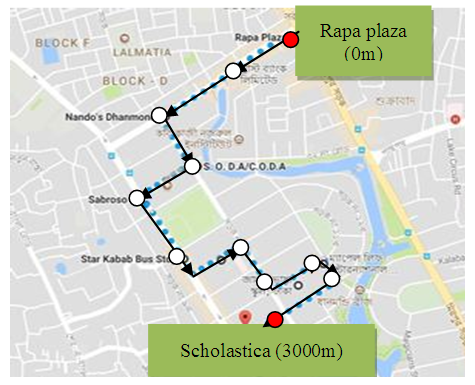 | Figure 3.1. Study area of Dhanmondi (Source: Google Map) |
The study area of Gulshan was 1,800m long and divided into 10 sections. | Figure 3.2. Study area of Gulshan (Source: Google Map) |
The study area of Bashundhara R/A was 1,700m long and divided into ten sections. 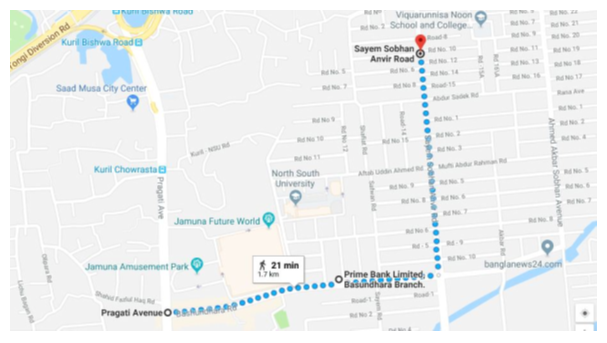 | Figure 3.3. Study area of Bashundhara R/A (Source: Google Map) |
3.2. Plan of Actions
The plan of actions set for this study was as follows:1. At first, a detailed condition survey of the study area was conducted. During the condition survey work, efforts were made to find out the structure, materials and distress condition (severity and frequency) of the sidewalks of the study area.2. Then a matrix was developed to calculate the SCI of the sidewalks.3. A table was developed, which would include the range of SCI for different conditions of the sidewalks.4. Then the values of the calculated SCI were accumulated and the SCI ratings from public’s opinion and the Engineer’s /Surveyor’s visual inspection were summarized.5. The SCI ratings based on Public opinion were collected from conducting a survey, while the Engineer’s /Surveyor’s SCI ratings were obtained from condition survey of each of the selected sections.6. The SCI value, which should be considered after receiving the rating from the Public’s opinion and the Engineers/Surveyor’s visual inspection, were averaged.7. Next, the mean value of SCI (the arithmetic mean of Calculated SCI, Public’s opinion based SCI and the Engineer’s/Surveyor’s visual inspection based SCI) were calculated for each section of all locations. This mean value is supposed to be the “Final SCI” of that particular section.8. Now, the calculated SCI value and the final SCI value were plotted against each other to form a best-fitted trend line (i.e. having maximum value of goodness of fit or R2).9. After that, SCI range would be validated statistically with 95% confidence level.10. Finally, 20% data from each location would be selected randomly for the validation process of SCI protocol.
4. Result Analysis
As indicated earlier, the study areas of this study were Dhanmondi R/A, Gulshan and Bashundhara R/A. The detail condition survey revealed that the sidewalks of the study area have a good number of different distresses, which are presented in the following figures: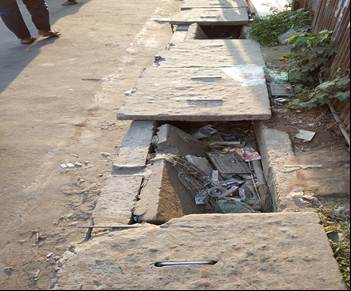 | Figure 4.1. Missing Concrete cover of Subsurface Drain |
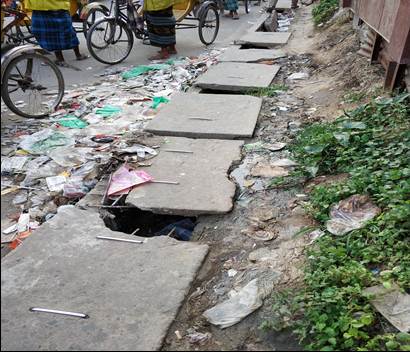 | Figure 4.2. Broken Concrete Cover of Subsurface Drain |
 | Figure 4.3. Broken Concrete Slabs |
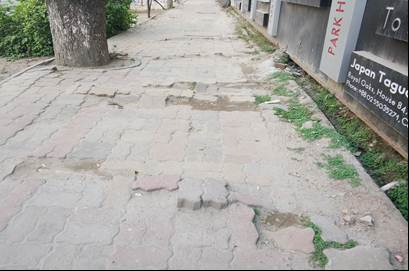 | Figure 4.4. Surface Deformations |
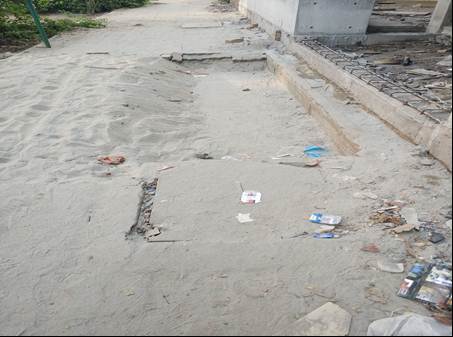 | Figure 4.5. Damaged Base Layer |
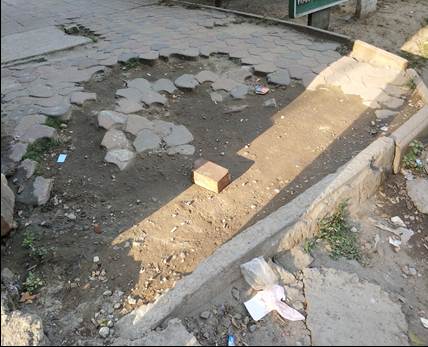 | Figure 4.6. Brick or Tile missing |
 | Figure 4.7. Utility Cut Holes |
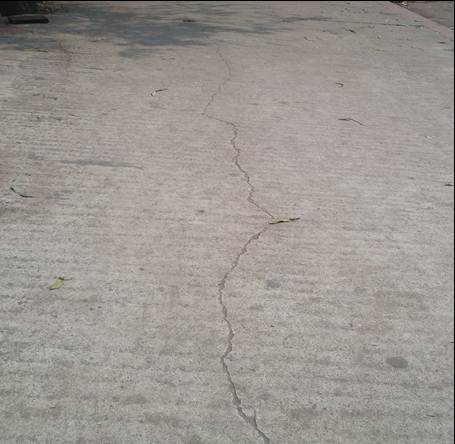 | Figure 4.8. Longitudinal Crack |
 | Figure 4.9. Transverse Crack |
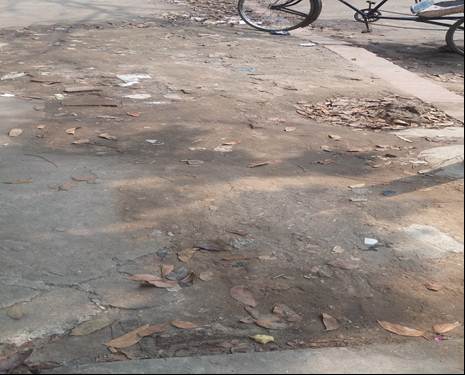 | Figure 4.10. Loss of Cement Concrete (CC) |
 | Figure 4.11. Tree Roots Damage |
5. Calibration and Validation
5.1. Calibration of SCI
Table 4.1 was developed as the basic SCI matrix for calculating raw value of SCI.Table 4.1. SCI Matrix
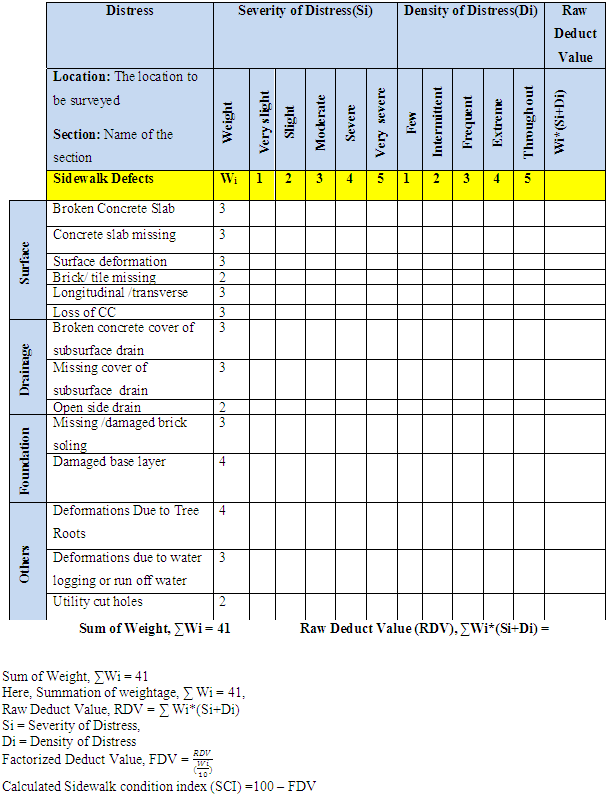 |
| |
|
5.2. Initially Proposed Sidewalk Condition
Initially ranges of SCI were proposed for different sidewalk conditions, as shown in Table 4.2.
5.3. Adjustment of Calculated SCI
The adjustments of the calculated SCI are shown in Table 4.3.Table 4.3. Adjustment of Calculated SCI
 |
| |
|
The SCI value which should be considered for the Public’s opinion and the Engineers/Surveyor’s visual inspection would be the average or mean value of that SCI range designated by them. This was done by conducting a survey on each section of the study area.The mean value of SCI (the arithmetic mean of Calculated SCI, Public’s opinion based SCI and the Engineer’s/Surveyor’s visual inspection based SCI) would be calculated for each section of all locations. The mean value is supposed to be the final SCI.Final Sidewalk Condition Index (SCI) = arithmetic mean of Calculated SCI, Public’s opinion based SCI and the Engineer’s/Surveyor’s visual inspection based SCI.For Adjusting the Calculated SCI this following Linear Equation should be used:Adjusted SCI = 1.7139*Calculated SCI - 77.223.This linear equation is developed by comparing the Calculated SCI and Final SCI, as shown in figure 4.1.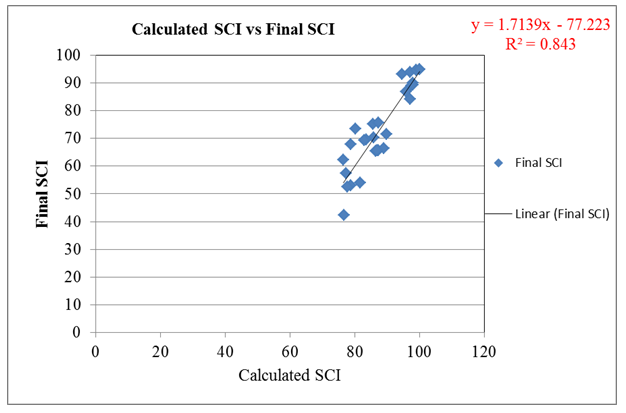 | Figure 4.1. Calculated SCI vs. Final SCI |
So, Adjusted SCI= 1.7139*Calculated SCI - 77.223This Adjusted SCI will be termed as “The Side walk condition Index (SCI)” for that particular section or location.
5.4. Summary of Sidewalk Condition of the Study Areas
The summary of sidewalk conditions of the study areas are presented in figures 4.2, 4.3 and 4.4. | Figure 4.2. Sidewalk Conditions of Bashundhara R/A |
 | Figure 4.3. Sidewalk Conditions of Dhanmondi R/A |
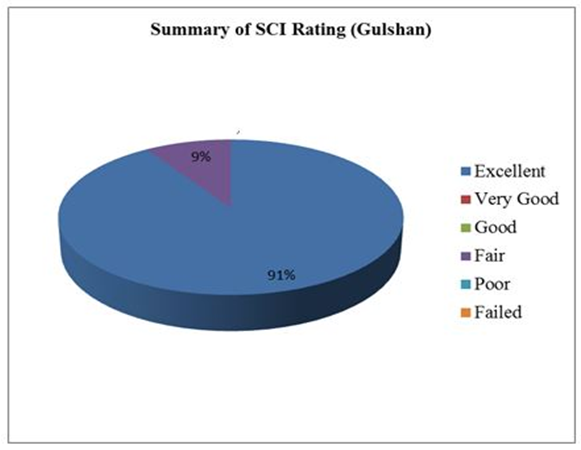 | Figure 4.4. Sidewalk Conditions of Gulshan |
5.5. Validation of the Study
As indicated, the validation of the study consists of two parts: (1) Validation of Ranges, and (2) Validation of SCI Protocol.
5.5.1. Validation of Ranges
For validating the initial SCI range, the results obtained from 29 sections of three study areas and the results obtained from previous studies were used. The results obtained from this study are organized here according their corresponding rating. These results are validated then statistically with 95% confidence interval using the confidence interval equation. The equation that is used for the validation of ranges is as follows:Confidence interval =  Here,
Here, = Mean Valuez = the point estimate for the population proportion is the sample proportion, and the margin of error is the product of the z value for the desired confidence level (e.g., z = 1.96 for 95% confidence)S = Standard Deviationn = No. of Samples.The validated Sidewalk Condition Index (SCI) ranges are shown in Table 4.4.
= Mean Valuez = the point estimate for the population proportion is the sample proportion, and the margin of error is the product of the z value for the desired confidence level (e.g., z = 1.96 for 95% confidence)S = Standard Deviationn = No. of Samples.The validated Sidewalk Condition Index (SCI) ranges are shown in Table 4.4.Table 4.4. Validated SCI Range
 |
| |
|
5.5.2. Validation of SCI Protocol
From each location, 20% sections were selected randomly for the validation of SCI protocol Process. Table 4.5 shows the validation of SCI protocol process.Table 4.5. Validation of SCI Protocol
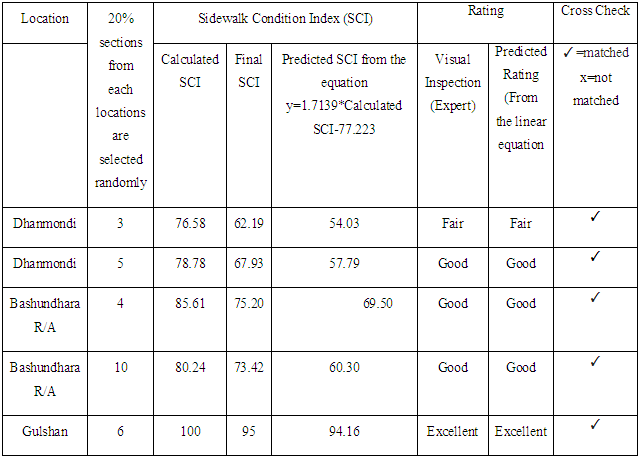 |
| |
|
5.6. Guidelines for Executing the SCI Protocol
• The length of each section should be 100m or less as followed by the surveyor/engineer.• During the condition survey, the engineer/surveyor will use the proposed SCI matrix to record distress and severity.• Once the table is filled up by the engineer/surveyor, the raw deduct value will be factorized by dividing the raw deduct value with 4.1. This factorized value will be termed as FDV (Factorized Deduct Value).• The initial SCI value (calculated SCI) would be then calculated by deducting the factorized deduct value (FDV) by 100.• Once the initial SCI is calculated, this calculated SCI value will be adjusted using the following predictive equation:Final SCI = 1.7139*(Calculated SCI) – 77.223• Finally, the section of the sidewalk should be rated (Excellent/Very Good/Good/Fair/Poor) by using the validated SCI range table (Table 4.3) with 95% reliability.
5.7. Guidelines for the Implementing Agencies to Execute the SCI Protocol
The study proposes a “Future assessment plan of Sidewalk” that can be implemented by the implementing agencies in two ways. They are-(1) Yearly evaluation(2) Periodic evaluation.1. Yearly evaluation: (Per year)Yearly evaluation of the sidewalks should be done by authority associated with sidewalk maintenance. The responsible department can conduct a windshield survey every year. Based on the results obtained in that survey, the following department will carry out a detail condition survey.2. Periodic evaluation: (Every three year) This kind of evaluation should be done once in every three years. Based on the results obtained from the yearly evaluation, detailed condition survey will be conducted on the marked locations/areas.For executing the above strategies the following procedures should be followed by the implementing agencies:1. First of all, a condition survey of the sidewalk should be conducted. The department should divide the full sidewalk network into different sections. A full sidewalk network should be surveyed within a 3 year study period. 2. After that, the department should calculate the initial SCI and the final SCI using the equation “Final SCI= 1.7139*Calculated SCI-77.223”. The department should follow the SCI protocol as described in Section 4.6.3. After rating, the department should summarize the total length of the sidewalks in the network that fall into (Excellent, Very Good, Good, Fair and Poor) categories using the validated ranges of SCI (Table 4.3). For example if a network of sidewalk is about 20km, the department should summarize what are the percentages of the sidewalks that fall into (Excellent, Very Good, Fair and Poor) criteria.4. A sidewalk in poor/failed condition would be considered as candidate for the re-construction and others will be the candidate for minor to major constructions.5. The department will develop rough estimates for obtaining the cost per unit area of a sidewalk. They will also develop the rough estimate for reconstruction, major and minor repair.6. Based on the estimated percentages and unit cost, the department will come up with a budget especially for sidewalks and integrate that estimated cost with the department’s main yearly budget.7. On a yearly basis, the department will develop a prioritization scheme to prioritize the projects for re-construction/major/minor repair.8. Once the prioritization is done, the agency will be able to develop a rational budget for the sidewalk as well as for the department.
6. Conclusions and Recommendations
6.1. Conclusions
v Dhaka being one of the most densely populated mega cities of the world needs planned infrastructure. v To find out the complications of the sidewalk system of Dhaka city, three locations were taken into consideration and were divided section-wise. Detailed survey has been performed various times in order to come up with a general methodology for evaluating the sidewalks of Dhaka city.v Several iterations were done to calibrate and validate the proposed sidewalk assessment plan. The calculated result/condition of the sidewalk that was assessed initially by considering the surveyed distresses the frequency/severity of the distresses on the study areas, prepared by the engineer/surveyor, were further fine-tuned considering the public opinion about the section of the sidewalk and the engineer’s/surveyor’s personal opinion based on his/her visually inspected result. A final value was obtained considering all these factors and it was then adjusted using the following equation: Final SCI = 1.7139*(Calculated SCI) - 77.223.v Once the SCI assessment table is filled up by the engineer/surveyor, the initially calculated SCI value can be adjusted using the above equation. Then, it can be rated as (Excellent, Very Good, Good, Fair and failed) considering its SCI value with the validated SCI range.v Currently, the departments (DNCC, DSCC, RAJUK, etc.) do not have any specific policy for the construction/reconstruction and major/minor repair of the sidewalks. Most of the sidewalks are built for a design period of five years. The department usually constructs a new sidewalk while constructing the roadway. So, this study proposes a future assessment plan of sidewalks that can be used as a policy of sidewalk management and maintenance by the authority or the related departments (DNCC, DSCC, RAJUK, etc.). v For executing this protocol, first of all a detailed condition survey should be conducted and the department should integrate the obtained results developed from SCI values and should summarize the percentages of the sidewalks that fall into (Excellent/Very Good/Good/Fair/Poor) criteria. Then, the department should follow its prioritization scheme to prioritize the obtained results. The department will develop rough estimates for obtaining the charge per unit area of a sidewalk for developing an estimated budget for a sidewalk.v Based on the estimated percentages and unit cost, the department will come up with a budget especially for sidewalks and integrate that estimated cost with the department’s main yearly budget. Once the prioritization is done, the agency will be able to develop a rational budget for the sidewalk as well as for the department. If the agency doesn’t get full funding required from the funding agencies, they would rank the sections based on its SCI results and allocate the assigned budget for those sections. So, a full network of sidewalks could be evaluated and maintained within a three year study period.
6.2. Recommendations for Future Work
v Since cost analysis was not done, it should be carried out in future.v More areas other than Dhanmondi, Bashundhara and Gulshan could have been studied for calibration and validation purpose. This would have increased the reliability of the results obtained.v Since it was found that that most of the sidewalks were confined, the authority should take it into consideration of expanding them.v The monitoring of the sidewalk system should be merged with the road management system so that both the systems can get equal importance from the maintenance agency as well as the government while allocating budget.v Apart from all these, the road maintenance authorities could also set some principles before constructing sidewalks. Building sidewalks with standard sizing and having efficient drainage system along with universal accessibility will allow the pedestrians as well as the physically disabled people to use sidewalks more often. This will decrease the number of fatalities of pedestrians while using roads.
ACKNOWLEDGMENTS
The authors would like to thank North South University’s Department of Civil and Environmental Engineering (DCEE) officers and staffs for supporting them to conduct this research. Appreciation is also towards all the respondents who took the valuable time to participate in the survey.
References
| [1] | Mahmood, A. (2017, August 17). Dhaka retains 4th least livable city position in Global Livability Index. Dhaka Tribune. Retrieved from https://www.dhakatribune.com/. |
| [2] | Health Bridge. (n.d.). Moving Dangerously, Moving Pleasurably: Improving Walk ability in Dhaka. Retrieved from https://healthbridge.ca/images/uploads/library/BRT_Walkability_Strategy_Summary_final.pdf. |
| [3] | Government of the People’s Republic of Bangladesh. (2012, June). Traffic Accident Study In Dhaka City. Retrieved from https://issuu.com/bayesahmed/docs/traffic_accident. |
| [4] | Islam, S., & Miah, S. (Eds.). (2014). Dhanmondi. In National Encyclopedia of Bangladesh. Retrieved from http://en.banglapedia.org/index.php?title=Dhanmondi. |
| [5] | Santos, P. (2015, April 2). The City Fix [Supplement material]. The eight principles of the sidewalk: building more active cities. Retrieved from http://www.thecityfix.com/. |
| [6] | Source: City of Bellevue, Youth Link Survey (Bellevue, WA, 1991). |
| [7] | Active Design Shaping the Sidewalk Experience New York, NY. (2013). Retrieved from https://www1.nyc.gov/assets/planning/download/pdf/. |
| [8] | Boodlal, L. Accessible Sidewalks and Street Crossings - an informational guide. Retrieved from U.S. Department of Transportation website: http://www.bikewalk.org/pdfs/sopada_fhwa.pdf. |
| [9] | Shaon, A. R. (2017). Development of a Methodology for Assessing the Condition of Sidewalks in Dhaka City. |























 Here,
Here, = Mean Valuez = the point estimate for the population proportion is the sample proportion, and the margin of error is the product of the z value for the desired confidence level (e.g., z = 1.96 for 95% confidence)S = Standard Deviationn = No. of Samples.The validated Sidewalk Condition Index (SCI) ranges are shown in Table 4.4.
= Mean Valuez = the point estimate for the population proportion is the sample proportion, and the margin of error is the product of the z value for the desired confidence level (e.g., z = 1.96 for 95% confidence)S = Standard Deviationn = No. of Samples.The validated Sidewalk Condition Index (SCI) ranges are shown in Table 4.4. Abstract
Abstract Reference
Reference Full-Text PDF
Full-Text PDF Full-text HTML
Full-text HTML


